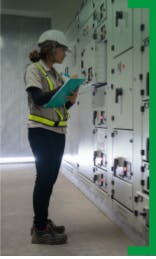From the inconvenient to the catastrophic, a transformer failure can mean anything from a slight glitch to months of business disruption. And those businesses with transformers insulated by mineral oil are particularly at risk. With a high calorific value, mineral oil transformer fires burn intensely and are notoriously difficult to control — posing significant health and safety risks. This is before the consequences of transformer failure are felt by the operator or owner in terms of downtime, business continuity, loss of revenue, and site damage — all of which can extend into millions of dollars. With all that said, the importance of businesses having the ability to accurately assess and mitigate transformer risk cannot be overstated.
Rightly, senior managers are concerned about business continuity and the safety of the operations that underpin it. However, are these business priorities being translated into action on the ground? Our research, The MIDEL Transformer Risk Report 2020, highlights a gap.
Conducted to enhance the understanding of transformer-related risks, our research analyzed key concerns and risk mitigation trends, while also garnering opinion on board awareness and priorities. It revealed that while lowering risk is given universal priority and engineers are diligent in making recommendations to that end, many of those recommendations are not being implemented.
The survey aims to enhance board-level understanding of transformer-related risks. Responses were gathered from transmission (11%) and distribution (15%) operators, commercial and industrial (33%) and renewable energy generators (5%) across EMEA, the Americas, and APAC. We also received input from researchers, oil and gas engineers, testing and safety providers and manufacturers.
Recommending Risk Mitigation
From the results, it is clear that engineers are making a good spread of recommendations to mitigate transformer-related risks. Switching to condition-based monitoring stood out as an emerging preference with nearly half of survey respondents (49%) stating they had proposed it.
"I think everybody accepts there has been a positive shift in recent years away from scheduled monitoring and interventions to those based on asset condition. While this promotes efficient use of time and resources, it also helps to foster a stronger safety culture and one that is inherently much more aware of the associated risks to people, property, and the environment around the asset. With our transformer fleet, this approach has helped us to not only put a retrofilling program in place, but also to prioritize assets in the worst condition so that we can upgrade and de-risk those units first," said a senior engineer at a U.K. utilities provider.
Maintenance regime changes, asset replacement, asset repair and reconditioning, and substation upgrades were also prevalent. However, many of these recommendations are not being implemented fully — only 44% are to be precise, with a further 41% of businesses electing to take only some of the recommendations forward.
A combination of factors stand in the way of senior managers pursuing all relevant avenues to mitigate transformer-related risks. Indeed, CAPEX was cited as the most significant barrier (56%). However, more pressing commercial (38%) and engineering (36%) priorities were also cited frequently. It might seem perfectly logical to try and save money when replacing assets, for example, and engineers themselves might choose to do so, but an alternative might involve lower maintenance requirements and fewer scheduled outages, which might not be so obvious if you're just comparing quotes. This is how an otherwise "prudent" budget decision taken in isolation could negatively affect network resiliency, heighten risk, and be more costly in the long term.
Confident Decision Making?
When considering the significant implications of leaving transformer risks unmitigated, it's important that engineers' concerns are heard and their recommendations considered, if not fully implemented. However, our research revealed that this may not always be the case.
Of those that we spoke to, just over half (56%) said they felt confident in their senior management team's awareness of the risks and their ability to plan accordingly. That leaves just under half of engineers who weren't confident or didn't feel like they had enough insight to say either way.
Could one reason for the lack of action be that senior management doesn't fully understand the seriousness of mitigating transformer-related risks? It is quite possible. The links between failure and risks are intricate. From CAPEX, OPEX, and safety, to insurance, environmental impacts, and asset integrity, it's understandable if not everyone on the board is up to speed. But transformer failure can impact business continuity for months, so it's not something boards will want to leave unmitigated.
So, if the nuances of risk mitigation are getting "lost in translation" engineers may need to more fully explain the case to catch the ear of decision makers and what seems obvious to an engineer, may not be perceived in the same way by others.
Improving the Substation to Boardroom Connection
One way this can be accomplished is by ensuring transformers are placed on the risk register. Many businesses will already have some form of risk register in place to identify, assess, and manage risks but our survey revealed only 14% thought it was being used by senior managers to mitigate risks. Having transformers included on this register provides them with more visibility at the C-suite level as well as for associated regulatory compliance.
Transformers are often thought of as "out-of-sight, out-of-mind" assets, so it's understandable people expect them to work without issue, if they even think of them at all. However, they can and do fail, and since the potential consequences can be severe, their presence on risk registers is incredibly important.
At the same time, it may benefit decision makers to be more transparent in communicating the reasons to deny or delay recommendations. It's important that engineers feel like they have been listened to and can leave the room feeling confident in their senior management team's understanding of the risks and the options available.
Strengthening the connection between the substation and the boardroom gives industry a focus for improvement. Businesses need to ask themselves what actions need to be taken for confidence in these decisions to rise? Whether it's an issue with communication or education, or both, each scenario will require a tailored approach.
Considering New Options
On a more practical note, the way assets in all industries are monitored and maintained is changing, encapsulated by a growing trend to consider asset management and safety more holistically. Transformers are no different. At the same time, engineers are increasingly faced with aging fleets that are not only time consuming to maintain but can also increase risk. While condition-based monitoring stands to alleviate many of these concerns, physical improvements such as retrofilling will continue to be important, particularly for mitigating risk at scale.
When we spoke to industry colleagues about what transformer risk mitigation strategies their company uses, a noticeable swing was in effect. While time-based maintenance is still a common approach (58% of respondents reported they use it), industry professionals predict this will change in the near future as engineers seek to maintain assets in the most cost-effective way.
This reflects a growing trend toward more holistic asset management approaches, in part, enabled by unprecedented levels of insight afforded by digitalization. As infrastructure digitalizes, assets can report their condition in real time, meaning engineers are no longer required on site in order to effectively manage asset risks.C As such, the use of condition-based monitoring looks set to increase rapidly.
Physical Mitigation Techniques
However, not all risks can be mitigated by digital techniques. Indeed condition-based monitoring is often more like the doctor that diagnoses the problem, rather than prescribing the cure itself. Then, it may be up to more physical solutions to hold the answer.
Retrofilling of transformers from mineral oil to fire-safe, readily biodegradable ester fluids is expected to increase in use. Not only is it a proven and cost-effective technique for reducing fire risk, it can also elongate the lifespan of the transformer and improve resilience to the implications of overloading. In fact, our results suggest that its use as a risk mitigation technique is set to increase.
Ultimately, the safety goal for any company is to operate with as little risk as possible. The impact of failure on business continuity and reputation will always far outweigh the cost of mitigating transformer risks. That being so, it is in every senior management team's interest to work with their engineers to get to grips with transformer-related risks. Together, businesses could substantially reduce the risk of failure, fatality, or fire posed by transformers with just a few well-considered measures.
The survey, which attracted responses from transmission and distribution operators, original equipment manufacturers and commercial and industrial operators across EMEA, the Americas and APAC, aims to enhance board level understanding of transformer-related risk. The report assesses key concerns and risk mitigation trends as well as garnering opinion on board awareness and priorities.
To download the report, visit here.



